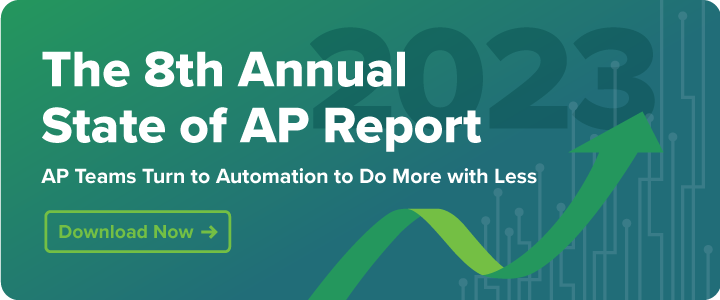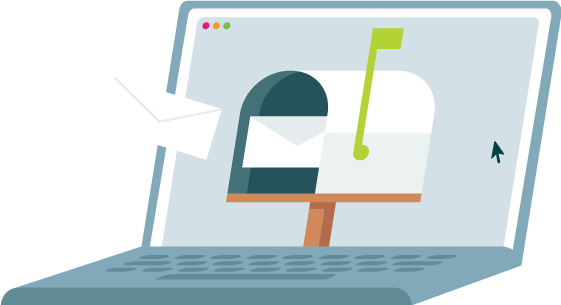Digitizing and automating accounts payable is imperative for modern, growing businesses. Not only does this process enhance efficiency, visibility, and transparency, it also helps organizations save time, and money and achieve digital transformation initiatives. In this blog, we explore the top 9 reasons why organizations should digitize accounts payable. But first, here are some basics to help you understand exactly how digitization works in accounts payable.
Key Takeaways
- Digitizing and automating accounts payable (AP) processes leads to streamlined and efficient operations.
- Businesses using digital technologies experience significant cost and time savings.
- Digitization enhances security, reduces errors, and provides real-time visibility into the invoice-to-pay process.
What Is Digital Accounts Payable?
Digital accounts payable refers to the technology used to automate the end-to-end accounts payable process. The process of digital accounts payable involves ditching manual and paper based processes with a more efficient and streamlined AP workflow. A few examples of digital accounts payable are:
- Paperless Invoices
- Automated Invoice Capture
- Automated Workflows
- E-Payments
- Real-time Visibility and Analytics
How Do You Digitize Accounts Payable?
Digitizing accounts payable is the first step to automating the entire end-to-end AP process. We highlighted the most important steps to take when making the transition below.
Switch to Automated Invoice Processing
Manual invoice processing is not only time consuming, but costly. Automating this process helps remove manual data entry, reduces errors, supports a strong supplier relationship, and ensures that all bills are paid on time, or even early if a vendor offers early-pay discounts.
Streamline Invoice Approvals
With digitized accounts payable, paper invoices will be traded for electronic or digitally scanned invoices — removing the need for paper based invoice approvals. For this reason, it’s important to set up invoice approval processes and standards that will enable streamlined review, approvals, and invoice payment processing.
Remove Manual Data Entry
To have a completely digitized accounts payable process, you need to remove manual data entry. Organizations should identify manual entry points for AP data and incorporate them into their broader digitization strategy. Utilizing OCR technology with human review can ensure 99.5% accuracy on invoice capture, and eliminates the need to manually input data from physical invoices.
Automate Invoice Matching
The last essential part of digitizing accounts payable involves automating the invoice matching process. This process involves invoice verification, matching invoices to a purchase order, or even to its delivery receipt, and begins by tracking down all paperwork within your accounts payable process. This ensures that all details within your system accurately match the invoice and amounts paid across the department.
Why Is It Important to Digitize Accounts Payable?
Technology evolves each year and at a faster rate than ever before. Businesses that undergo digital transformations and leverage the combination of automation and data analytics gain a competitive advantage in their respective markets. These businesses can scale up processes more easily, take advantage of tools and insights, and are generally more flexible and agile.
This trend is not only true in a general sense but applies specifically to the accounts payable process. Older AP practices involve manual data entry, handling of paper checks, and processes that aren’t only inefficient, but error prone and lacking in their ability to provide useful data or KPIs that could inform decision-making and improvements.
Digitization of the AP process and deployment of modern tools are fast transitioning from being nice-to-haves to must-haves if businesses wish to remain competitive, especially amid rising inflation and worker shortages. This was illustrated by the COVID-19 pandemic–AP departments that relied on manual processes and the handling of paper checks were unable to transition seamlessly to remote work.
Unlocking the benefits: 9 Reasons to Digitize your Accounts Payable Process
By adopting modern AP software and tools, organizations position themselves to keep pace with digitization by continually improving their level of automation over time regardless of where they currently are in their AP journey. We outlined the top nine reasons to digitize your AP process below.
1. Offer More Convenience
AP tools and software are designed to make the AP process more streamlined and easier. For example, the right tools eliminate the need for manual data entry and the errors that come with it by automatically capturing and coding header and line-level data from invoices, with the ability to scale to any volume. Through a single login, users can view all AP activities easily and conveniently with no need to hunt through multiple files, programs, or physical papers.
Additional points of convenience include easier invoice capture, approval, payment authorization, and simplified reconciliation. Supplier interfaces improve supplier relationships and take the need to field vendor questions off the plate of the AP department. Digitization also comes with the ability to send payments digitally and in multiple formats, and to schedule those payments in a way that optimizes cash flow.
2. Save Time and Money
Many factors contribute to extra costs and extra time for AP departments that don’t use digital technologies. Manual data entry and the handling of paper checks takes more time than automated invoice capture and sending digital payments. Moreover, organizations that don’t use AP automation tools tend to spend more per invoice than those that do.
With digitization, you free up employee time to focus on more strategic or higher-value tasks while also saving money. And if your invoice volume grows with your business, you’ll find that using digital tools makes it much easier to handle those increases without needing to use employee overtime or hire more individuals.
The use of electronic payment methods like virtual cards also helps avoid payment delays and inefficiencies–which leads to more saved time and more saved money due to the ability to optimize payment strategies and timing.
3. Scale your Team’s Capabilities
As the number of invoices grows, accounts payable departments may feel like they need to hire additional AP employees. However, hiring and training new staff is not the most efficient or cost-effective option. Additionally, hiring new talent does not diminish other invoice management challenges such as human error, duplicate payments, or wasted resources.
61% percent of survey respondents who have employed end-to-end automation are processing more invoices and payments with the same size team. By leveraging digitization and an end-to-end accounts payable process, your team can be more efficient and is better able to scale.
4. Reduce errors
When the AP process isn’t automated, errors are more likely to occur, especially if the amount of invoices being processed exceeds the capabilities of an already busy team.
For the Boston Celtics, the number of invoices would rise during the season, stretching their AP team beyond capacity. Amid the confusion, it was easy for invoices to get lost, extending the time to payment. Once the invoices were processed, they had to be sent to a data warehouse where they were uploaded and filed. Invoice processing was so time-consuming for the team, that data verification was difficult to manage. Since the Celtics have a high standard for accuracy, their AP department decided to investigate an AP automation software that would allow them to transform their entire workflow into a reliable and scalable end-to-end process. By partnering with MineralTree, they were able to replace their manual efforts with a more streamlined and automated AP workflow. Read the full case study here.
5. Capture Early Payment Discounts
With manual AP processes, many organizations find that they end up sending payments late or introducing errors due to inefficiencies. But with digitization, organizations are in a position to not only streamline processes but also take advantage of early payment discounts since they’re able to send payments faster.
MineralTree takes this even further by reaching out to suppliers on your behalf for digital payment and virtual card onboarding. This lets you maximize cost savings and rebates by converting checks into virtual cards and other ePayments.
6. Enhance Security
Using AP automation tools and digital payment methods also improves the security of your AP processes. Virtual cards, for example, are much more secure than just about any other payment method due to their use of a one-time code or token.
Proper AP automation software uses the same level of security and encryption to handle payments that banks use. And each invoice and payment comes with a fully digital audit trail, making it easy to check for discrepancies and identify problems. Check fraud and theft of routing numbers become a thing of the past.
Automation also reduces regulatory risk when software comes with built-in security features. So, you can not only offload managing supplier payment details, but apply best-in-class security controls, and ensure complete auditability across your AP process.
7. Improve Visibility
With a single login, you can use AP automation tools to view and manage the entire invoice-to-pay process from a single pane of glass. The ability to manage AP processes centrally helps ensure consistency and visibility across user roles, business units, and locations.
Digital payments can also be accounted for much quicker than paper checks. This makes it much less likely that you’ll end up with an accounting discrepancy or a bounced check.
8. Gain Business Insights
Automated and digitized processes make it possible to collect loads of data. With the right software, this data can be easily viewed in automatically generated reports, providing insights that inform decision-making and lead to improvements.
By replacing manual, static reporting with real-time dashboards that visualize KPIs such as invoice aging, payment mix, and rebates––across operating units, locations, and suppliers–your organization can make faster and better decisions that are aligned with your strategic business objectives.
9. Build Better Supplier Relationships
Supplier relationships can be directly impacted by the AP process, which is why it is so important to ensure accuracy and timeliness. With all the information about invoices and pending payments in one system, suppliers can login and get answers to their questions without having to make a phone call, sit on hold, or get routed from person to person. If they want to know when to expect a payment, this information is at their fingertips.
Not only that, but automated AP processes lead to fewer errors and faster, more efficient payments. Easier payment processes combined with improved visibility easily keep suppliers happier and reduce churn. For most organizations (71%), strengthening these relationships has become even more important over the past year. By incorporating automation into the AP workflow, companies can improve the supplier payment process, leading to better relationships with vendors.
For the Baltimore Ravens, supplier payments created complex challenges. With over 2,500 vendors to manage, the pressure fell on the AP team to finalize payments in a timely manner. Since their AP process was manual, employees would have to enter and code invoice data, distribute hard copies of invoices for approvals, and mail out paper checks. However, in 2019, a few strategic vendors noted that they would only accept payment via ACH transfer. Their team had previously investigated point solutions that would only address parts of the AP process. However, when trying to carve out time to ensure setting up ACH would go smoothly, they realized only an end-to-end automation solution could deliver what they were looking for. Read the full case study here.
Getting Started with Digitizing AP – How MineralTree can Help
MineralTree’s TotalAP solution automates the end-to-end AP process, from invoice capture through payment, and it does this while connecting with your ERP in real-time to keep everything in sync. TotalAP can increase AP efficiency by up to 80% while mitigating fraud risk and providing greater visibility and control over your AP spend.
Our dedicated supplier enablement team strives to optimize your payments and maximize your savings, security, and cash rebates. With continuous enrollment, we reach out to new and existing suppliers to accept ePayments and virtual cards. We’ve already helped more than 2,000 businesses streamline their payables while eliminating the administrative burdens of managing payment execution and supporting suppliers.
Accounts Payable Digitization FAQs
Which Technologies Can Help Automate the AP Process?
Automating the AP process can be accomplished with a variety of technologies. Some of the most common technologies used to automate the process include automated invoice capture through OCR technology, electronic invoicing, integration with ERP systems, electronic payments, or leveraging an AP automation solution, like MineralTree.
How Do You Digitize Accounting?
Digitizing accounting involves switching to an automated invoice processing system, removing manual data entry, streamlining invoice approvals, and automating invoice matching.
Can Accounts Payable be Paperless?
Yes! Accounts payable can be a mostly or completely paperless process. A paperless AP process means that traditional tasks that include paper, such as paper invoices, paper checks, data entry, and invoice approval, will all become automated.
Can Accounts Payable be Done Remotely?
Yes, accounts payable can be done remotely and in a hybrid work environment. This is done by leveraging an AP automation solution, which provides businesses with the ability to effectively manage their AP remotely while saving back-end office employees a strenuous workflow process.





